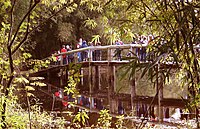
Photo from wikipedia
Stream discharge and chemistry (total suspended solids TSS, nitrogen N, and phosphorus P) were monitored for 15 months in six agricultural watersheds on the U.S. Mid-Atlantic coastal plain. Watersheds with similar… Click to show full abstract
Stream discharge and chemistry (total suspended solids TSS, nitrogen N, and phosphorus P) were monitored for 15 months in six agricultural watersheds on the U.S. Mid-Atlantic coastal plain. Watersheds with similar land uses and a range of hydric soils were used to test the hypothesis that hydric soils generate large storm discharges due to low permeability, resulting in watershed areas with high loss rates of N, P, and TSS. To test the hypothesis, discharge was monitored continuously, and a flow separation method quantified the base and stormflow contributions. Another primary goal was to measure base and stormflow chemistry to quantify N, P, and TSS export. Baseflow chemistry was monitored monthly, and 31 storm events were sampled. Baseflow chemistry varied little over the 15 months, but stormflow chemistry was dynamic, with three major patterns: (1) TSS and particulate N and P had large, brief peaks during the rising limb of storm hydrographs; (2) phosphate and ammonium had broader peaks close to maximum discharges; and (3) nitrate concentrations decreased during the rising limb, slowly returning to pre-storm levels. Event water yields were correlated with volume-weighted mean concentrations (VWMs) of N, P, and TSS, providing a basis for estimating VWMs of unsampled events. Export coefficients (kg ha−1 year−1) ranged over 22–33 for TN, 0.9–1.4 for TP, and 240–1140 for TSS. Most P and TSS export occurred during storms (71–99%), while most N export occurred during baseflow (52–84%). The discharge data did not support the hypothesis, and watershed slope, not hydric soils, was the major control on storm discharge. Surface ponding of water on hydric soils intercepted runoff, reducing the impacts of the low infiltration rates.
Journal Title: Biogeochemistry
Year Published: 2018
Link to full text (if available)
Share on Social Media: Sign Up to like & get
recommendations!